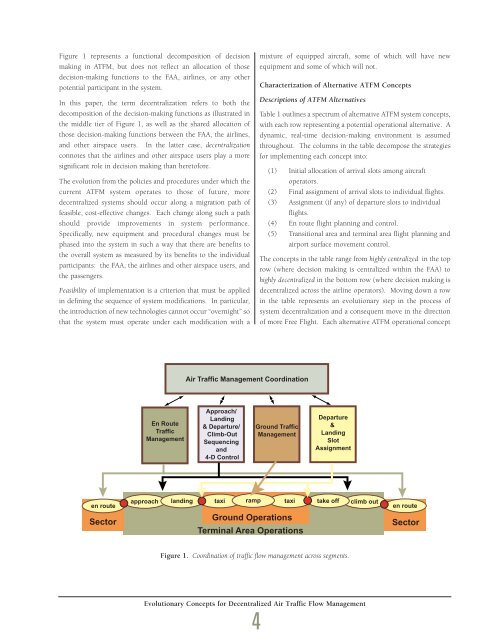1998 - Draper Laboratory
1998 - Draper Laboratory
1998 - Draper Laboratory
- No tags were found...
Create successful ePaper yourself
Turn your PDF publications into a flip-book with our unique Google optimized e-Paper software.
Figure 1 represents a functional decomposition of decisionmaking in ATFM, but does not reflect an allocation of thosedecision-making functions to the FAA, airlines, or any otherpotential participant in the system.In this paper, the term decentralization refers to both thedecomposition of the decision-making functions as illustrated inthe middle tier of Figure 1, as well as the shared allocation ofthose decision-making functions between the FAA, the airlines,and other airspace users. In the latter case, decentralizationconnotes that the airlines and other airspace users play a moresignificant role in decision making than heretofore.The evolution from the policies and procedures under which thecurrent ATFM system operates to those of future, moredecentralized systems should occur along a migration path offeasible, cost-effective changes. Each change along such a pathshould provide improvements in system performance.Specifically, new equipment and procedural changes must bephased into the system in such a way that there are benefits tothe overall system as measured by its benefits to the individualparticipants: the FAA, the airlines and other airspace users, andthe passengers.Feasibility of implementation is a criterion that must be appliedin defining the sequence of system modifications. In particular,the introduction of new technologies cannot occur “overnight” sothat the system must operate under each modification with amixture of equipped aircraft, some of which will have newequipment and some of which will not.Characterization of Alternative ATFM ConceptsDescriptions of ATFM AlternativesTable 1 outlines a spectrum of alternative ATFM system concepts,with each row representing a potential operational alternative. Adynamic, real-time decision-making environment is assumedthroughout. The columns in the table decompose the strategiesfor implementing each concept into:(1) Initial allocation of arrival slots among aircraftoperators.(2) Final assignment of arrival slots to individual flights.(3) Assignment (if any) of departure slots to individualflights.(4) En route flight planning and control.(5) Transitional area and terminal area flight planning andairport surface movement control.The concepts in the table range from highly centralized in the toprow (where decision making is centralized within the FAA) tohighly decentralized in the bottom row (where decision making isdecentralized across the airline operators). Moving down a rowin the table represents an evolutionary step in the process ofsystem decentralization and a consequent move in the directionof more Free Flight. Each alternative ATFM operational conceptAir Traffic Management CoordinationEn RouteTrafficManagementApproach/Landing& Departure/Climb-OutSequencingand4-D ControlGround TrafficManagementDeparture&LandingSlotAssignmenten routeSectorapproach landing taxi ramp taxiGround OperationsTerminal Area Operationstake offclimb outen routeSectorFigure 1. Coordination of traffic flow management across segments.Evolutionary Concepts for Decentralized Air Traffic Flow Management4
















